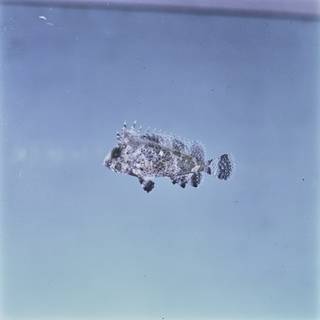WoRMS taxon details
Aploactinidae Jordan & Starks, 1904
- Genus Acanthosphex Fowler, 1938
- Genus Adventor Whitley, 1952
- Genus Aploactis Temminck & Schlegel, 1843
- Genus Aploactisoma Castelnau, 1872
- Genus Bathyaploactis Whitley, 1933
- Genus Cocotropus Kaup, 1858
- Genus Erisphex Jordan & Starks, 1904
- Genus Kanekonia Tanaka, 1915
- Genus Matsubarichthys Poss & Johnson, 1991
- Genus Neoaploactis Eschmeyer & Allen, 1978
- Genus Paraploactis Bleeker, 1864
- Genus Peristrominous Whitley, 1952
- Genus Prosoproctus Poss & Eschmeyer, 1979
- Genus Pseudopataecus Johnson, 2004
- Genus Ptarmus Smith, 1947
- Genus Sthenopus Richardson, 1848
- Genus Xenaploactis Poss & Eschmeyer, 1980
- Genus Aniculerosa Whitley, 1933 accepted as Paraploactis Bleeker, 1864
- Genus Aploactoides Fowler, 1938 accepted as Erisphex Jordan & Starks, 1904
- Genus Coccotropus accepted as Cocotropus Kaup, 1858 (Misspelling)
- Genus Cocotropis accepted as Cocotropus Kaup, 1858 (misspelling)
- Genus Corythobatus Cantor, 1849 accepted as Minous Cuvier, 1829
- Genus Eisphex accepted as Erisphex Jordan & Starks, 1904 (misspelling)
- Genus Karumba Whitley, 1966 accepted as Bathyaploactis Whitley, 1933
- Genus Membracidichthys Whitley, 1933 accepted as Paraploactis Bleeker, 1864
- Genus Stenopus accepted as Sthenopus Richardson, 1848 (misspelling)
marine, terrestrial
Not documented
Distribution Western Pacific and Indian Ocean, mostly in the Indonesian and Australian regions. Body usually velvety due to modified,...
Distribution Western Pacific and Indian Ocean, mostly in the Indonesian and Australian regions. Body usually velvety due to modified, prickly scales. With knoblike spines on head. Unbranched fin rays. Anal fin spines usually not distinct or lacking. Dorsal fin origin above eye or almost so, except in the genera Adventor and Peristrominous. First 3-5 dorsal fin spines usually appear segregated, either elevated or largely without membrane connection with the rest of the spinous dorsal. The first 3 or 4 spines form a separate fin in four species. Pelvic fin with less than 4 soft rays. Anterior isthmus with fleshy extension in most species. No palatine teeth. No gill slit behind the last arch. [details]
Froese, R. and D. Pauly. Editors. (2024). FishBase. Aploactinidae Jordan & Starks, 1904. Accessed through: World Register of Marine Species at: https://www.marinespecies.org/aphia.php?p=taxdetails&id=154253 on 2024-07-27
Date
action
by
![]() The webpage text is licensed under a Creative Commons Attribution 4.0 License
The webpage text is licensed under a Creative Commons Attribution 4.0 License
taxonomy source
Van Der Laan, R.; Eschmeyer, W. N.; Fricke, R. (2014). Family-group names of Recent fishes. <em>Zootaxa.</em> 3882(1): 1-230., available online at https://doi.org/10.11646/zootaxa.3882.1.1 [details] Available for editors  [request]
[request]
basis of record Fricke, R., Eschmeyer, W. N. & Van der Laan, R. (eds). (2024). ECoF. Eschmeyer's Catalog of Fishes: Genera, Species, References. <em>California Academy of Sciences. San Francisco.</em> Electronic version accessed dd mmm 2024., available online at http://researcharchive.calacademy.org/research/Ichthyology/catalog/fishcatmain.asp [details]
basis of record Fricke, R., Eschmeyer, W. N. & Van der Laan, R. (eds). (2024). ECoF. Eschmeyer's Catalog of Fishes: Genera, Species, References. <em>California Academy of Sciences. San Francisco.</em> Electronic version accessed dd mmm 2024., available online at http://researcharchive.calacademy.org/research/Ichthyology/catalog/fishcatmain.asp [details]
 Present
Present  Inaccurate
Inaccurate  Introduced: alien
Introduced: alien  Containing type locality
Containing type locality
From other sources
Distribution Western Pacific and Indian Ocean, mostly in the Indonesian and Australian regions. Body usually velvety due to modified, prickly scales. With knoblike spines on head. Unbranched fin rays. Anal fin spines usually not distinct or lacking. Dorsal fin origin above eye or almost so, except in the genera Adventor and Peristrominous. First 3-5 dorsal fin spines usually appear segregated, either elevated or largely without membrane connection with the rest of the spinous dorsal. The first 3 or 4 spines form a separate fin in four species. Pelvic fin with less than 4 soft rays. Anterior isthmus with fleshy extension in most species. No palatine teeth. No gill slit behind the last arch. [details]Habitat Coastal [details]

